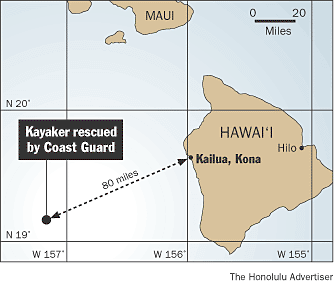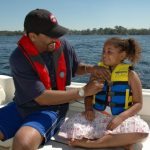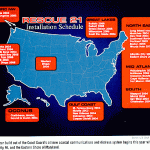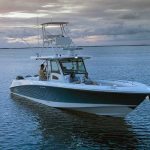On July 29th, 2002 John Stockton, went out for a short row in his new kayak. Some twenty-four hours later, after a Coast Guard HH-65 helicopter, C-130 jet and a Navy P-3 Orion aircraft went searching for him, he was plucked out of the water.
During this time period, the Coast Guard and Navy search more than 12,000 nautical miles of ocean, more than twice the size of the big island of Hawaii. Incidentally, that’s where Mr. Stockton went kayaking.
Courtesy of the Honolulu AdvertiserIn this case, both the Coast Guard and Navy can chalk up a successful Search and Rescue (SAR). Not every SAR case is successfully prosecuted, and boaters, all boaters should understand the dangers, as well as the good times involved in what is essentially a very safe sport.
While this is an extreme example of what can go wrong, we, and that is an all inclusive we, have found that truth is stranger than fiction. Problems while kayaking (or boating or sailing) happen everyday, but thankfully most victims don’t find themselves swept 80 miles out in the ocean.
Let’s examine Mr. Stockton’s case and see where he went wrong and what he could have done to minimize the danger he put himself in, as well as the danger to the rescue crews who went out to search for him. The lessons here work whether you’re going to take your vessel (any vessel, from a rowboat up to a 65′ cabin cruiser) away from the dock.
Weather
According to published reports, Mr. Stockton said “that strong winds capsized his kayakIt was just real big swells, 10- to 15-foot swells, wind just howling.” Rule one is checking the weather forecast prior to leaving the dock. And continually check the weather.
If the forecast shows a weather pattern or possible weather pattern that is adverse to the conditions your vessel is able to handle, stay home! If the weather begins to turn ugly, head for the nearest safe port.
Weather can turn your four hour cruise in to a twenty-four year nightmare (just ask the crew of the SS Minow), or ask Mr. Stockton if he’d like to repeat his twenty-four hour cruise? Somehow, I don’t think so
Safety Equipment
PFD’s
Safety equipment is an absolute, especially on a kayak. All kayaker’s, indeed all boaters, should wear a correctly sized Personal Flotation Device (PFD), what many of us still call a life jacket. Should your vessel capsize, it is suggested that you stay with your capsized vessel, and not try to swim to shore.
Swimming to shore, in most instances is a very dangerous decision, since the shore always looks closer than in reality. In addition, without a PFD, the chances for drowning and/or suffering from hypothermia increase logarithmically.
It’s not entirely clear from reports if Mr. Stockton had a PFD (life jacket), but he at least had a “yellow” jacket and an emergency blanket. It was reported that Mr. Stockton thought about swimming to shore. At the speed that his kayak moved away from shore, it would seem that the swim mostly likely would have killed Mr. Stockton.
Cell Phones vs. VHF radios
His entry into the emergency systems was precipitated by his use of a cell phone. While the Coast Guard frowns upon reliance on cell phones, in this case, Mr. Stockton’s use of his cell phone did save his life. Unfortunately, he left shore without a VHF radio, which could have communicated with the CG C-130 aircraft or the HH-60 helicopter.
The reason for the Coast Guard’s stance on cell phone usage is three fold.
1. Vessels are required, if they have a radio (for recreational boats having a vhf radio is not a federal requirement) to maintain a safety watch on VHF CH 16. CH 16 is the emergency hailing frequency. If you were to call a May Day, this is the frequency you would use.
2. If you call for assistance, and the Coast Guard doesn’t hear you, then other vessels within the area of your signal might hear you and either forward your message to the Coast Guard and/or offer assistance to your vessel.
3. Use and range of a cell phone is limited off-shore, and no one but the called party will, under most circumstances, hear your distress call.
Signaling Devices
Federal regulations require signaling devices on board most vessels. Signaling devices come in two varieties, audio and visual. Visual devices are further broken down into daytime and nighttime. Mr. Stockton had none, but by using his ingenuity, he made a signaling device.
For most kayaker’s, a plastic marine whistle and a signaling mirror tied to your PFD, would enable you to make yourself known during the ‘normal’ operating times of the vessel. Kayak’s, since they are not required to have lights, should only be used during the period of sunrise to sunset. If there is a chance that you’ll be out after sunset, a flashlight is recommended.
Courtesy of the West Hawaii Today via Associated PressA perfect example of how to use a signaling device, even a makeshift one is offered by Mr. Stockton. “Finally they got close enough and he flew right about 1 o’clock high. I had this blanket, a shiny metal emergency blanket, I tied it on the oar and I stuck it up there and I took off my jacket and I was waving it around. I was just like, Let them see me.”
It doesn’t do any good to shoot off your flares, or blow your whistle, if there is no one to see or hear them. Use them judiciously! Federal law requires only three (3) flares. Three flares don’t last long.
Flares and other pyrotechnics, as far as Federal Law is concerned, are only good for three years (all USCG Approved flares are marked with an expiration date). However, they most likely will last longer. Many Auxiliarists carry some recently expired pyrotechnics with them. These are the ones that they try to ignite or fire first.
The reasoning is that if the older, expired pyrotechnics works, then you now have one additional flare or other device to shoot off. If it doesn’t, then nothing ventured, nothing gained.
Float Plan
While not a required item, the Coast Guard strongly advises all boaters to file a float plan with a friend or neighbor. A float plan is a simple document that lists all the possible factors in a pre-planned voyage. The plan should include the type of vessel, its identifying features, make, model and power plant.
It also includes what extra safety equipment is kept on board, the intended path that the voyage will follow, including stops and the intended timing of the voyage (when you think you’ll be where, and when). The float plan also lists who is on the vessel, including names, addresses, ages and physical condition.
Should you not show up where and when expected, the holder of the float plan (and their can be multiple holders) can then call the Coast Guard, who would institute the beginning stages of the Search and Rescue system. The more information provided to the Coast Guard, the better the search planning and the faster the rescue.
Summary
Mr. Stockton is, as previously mentioned, an extremely lucky man. But if he had taken the proper precautions, his reliance on luck would have been markedly reduced. All boaters should learn from Mr. Stockton’s two days at sea. Learn what not to leave at home, and learn what to do in an emergency.
The United States Coast Guard Auxiliary is charged with assisting the Coast Guard in its Recreational Boating Safety (RBS) mission, among others. The Auxiliary assists in RBS, by providing to the public many different levels of boater education, geared for all ages, from children to adults.
Why not take a boating safety course, a sailing safety course or one of our navigation courses today. You can contact the Coast Guard Auxiliary either on the web at www.cgaux.org or call your local Coast Guard office. The Coast Guard can also be found in your phone book or on the web at www.uscg.mil.
The Associated Press, the HonoluluAdvertiser.com and 14th District of the United States Coast Guard contributed to this report.
Wayne Spivak is a member of, and holds various offices in, the U. S. Coast Guard Auxiliary, the Canadian and U. S. Power Squadrons, the National Safe Boating Association, and other prominent boating safety organizations. He is an Adjunct Professor at Lehman College, City University of New York.






